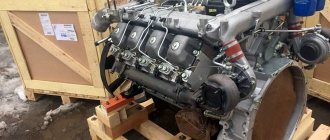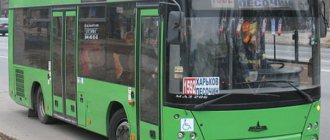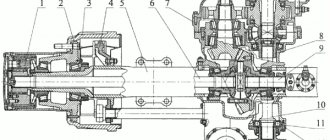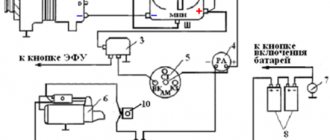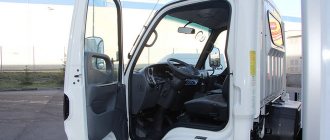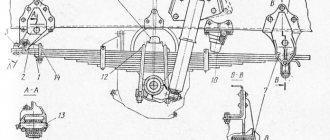City electric bus KamAZ-6282. Photo NefAZ
KamAZ-6282 is the first serial Russian electric bus jointly developed by NefAZ and KamAZ. This is a completely low-floor electric bus designed for urban environments. It uses the main components of traction electrical equipment, including an electric portal bridge and lithium-titanate batteries with an energy capacity of 80 kW with a maximum range of 70 km. Moreover, the battery life is up to 20,000 cycles. The bus is equipped with 3 doors and can accommodate up to 85 passengers. The cabin has 33 plastic, comfortable seats , a ramp and there are places for wheelchairs, and the low floor level makes it easier to board and disembark passengers, including people with limited mobility. It is equipped with such components and assemblies as: pneumatic braking system, low-noise screw electric compressor, power steering. The bus is comfortable for passengers and cost-effective for carriers.
History of creation
The steady trend in developed countries towards increasing the share of environmentally friendly modes of transport has also affected Russia in recent years. Since the late 2000s, manufacturers of urban passenger transport have created experimental models of electric buses , sending them for testing in the capital. However, the scope of the experimental work did not provide a reason to produce a series of machines of this class that were reliable in operation.
A prototype of the KamAZ-6282 electric bus. Photo Wikipedia
Large transport operators are actually avoiding a direct answer to the question about the results of testing their electric buses in the early 2010s. The Department of State Policy in the Field of Automobile and Urban Passenger Transport of the Ministry of Transport of the Russian Federation notes that electric buses are currently used as test vehicles in large cities such as Berlin, Moscow, Los Angeles, and Montreal.
Despite constant statements by officials about replacing trolleybuses with electric buses or simply introducing innovative transport, today there are only two electric buses operating in the whole of Russia. One of them is LiAZ-6274, which has been tested in Moscow since December 2016 on the M2 branch route. The desire of transport workers near Moscow to get a reliable and modern car is obvious. Having been the first to test the KAMAZ-6282 electric bus, based on the proposals of the State Unitary Enterprise MO Mostransavto, a second generation electric bus was created in the fall of 2016.
In the rhythm of the city
Unlike a bus, starting off is very smooth. It loses to the trolleybus only when accelerating, which is noticeably weaker. Even at low speeds, the hissing of brake chambers with energy accumulators can be heard everywhere in the cabin. Unlike trolleybuses, electric buses do not use electrodynamic braking completely. Engine braking occurs only in the presence of energy recovery, which charges the traction batteries of the electric bus. The trolleybus also has a section of brake resistors, which allows engine braking up to 5 km/h, which significantly saves the braking system.
When picking up speed and taking your foot off the accelerator pedal, jerking is felt in the electric bus, which indicates the need to adjust the electronics. In trolleybus depots, these issues are dealt with by teams created in the mid-1980s when the first trolleybuses with a thyristor-pulse control system were launched; in bus depots there are no such specialists.
On the way, it turns out that there is no fuel level sensor for the heating system! The driver will have to guess about fuel consumption. The buttons, although with pictograms, are not labeled, and when you sit behind the wheel for the first time, you become confused, having a chaotic set of keys.
It is impossible not to note the quiet operation of the hydraulic booster, which at first can be mistaken for an electric booster. On an electric bus, this was achieved by installing an electric pump.
After leaving the park, the LCD screen that replaced the instrument cluster showed the battery charge at 80%. Involuntarily you constantly glance at this indicator, slowly counting down the melting forces.
Since April, the electric bus has been operating every day, making one circuit in the morning and evening, returning to the park between trips to charge. The length of the route is 41 km. The maximum range recorded on this car was 56 km. In less than 4 months of operation, our electric bus has already managed to demonstrate its speed capabilities, without a doubt, showing an unstoppable character, once accelerating to a speed of 103 km/h on the Mozhaisk highway. Of course, before ultra-fast charging starts, there is no need to talk about stable operation. One such station was installed in Skolkovo, all that remains is to wait for its commissioning and evaluate the electric bus in full.
Detailed description, device
The car is easy to recognize by its characteristic design elements, including:
- stylized green belt on a white main body background;
- luminous route indicator located on the front mask;
- an emblem depicting a galloping horse.
NefAZ Electric bus KamAZ-6282. Photo Transport Center
The design of the electric bus, as well as its operational and technical characteristics, suggest that the KamAZ-6282 is a second-generation vehicle, which is distinguished from its predecessor (NefAZ electric bus model 529943) by a new design and filling . The new product was manufactured at the KamAZ scientific and technical center, where preliminary tests were carried out.
The difference between electric buses of the first and second generation is noticeable to the naked eye. These include:
- a hump on the roof that hides the lithium titanate batteries;
- volumetric wheel arches;
- glazing of increased area;
- new optics design.
The 12-meter KamAZ-6282 is completely low-floor. Its interior is designed for 85 passengers (of which 33 can travel sitting), which is more than the LiAZ-6274 electric bus can carry on board. But the total weight of the Kama electric bus (18.8 tons) is 800 kg higher. The interior of the passenger area is made in calm gray-blue tones , and the floor is finished with a laminate - like many modern buses of European brands. USB connectors for charging gadgets are mounted in the seat area . The car is adapted for people with limited mobility and passengers with strollers : a spacious storage area is provided in the central part of the cabin, and the middle door is equipped with a ramp.
To heat the interior, a conventional liquid circuit with a Webasto diesel heater is used (a similar solution is used to heat batteries). Since the carrier’s key requirement was to equip the vehicle with air conditioning, the new electric bus received a roof-mounted climate control unit (Eberspaecher AC-515).
The driver's cabin is separated from the passenger compartment by a solid partition. At the workplace, everything is like a regular NefAZ city bus, no worse and no better. Among the original solutions are an innovative dashboard in the form of a multifunction display, a three-position transmission mode selector (forward, reverse, neutral) plus a power steering activation key.
All power electrical equipment was designed by the private engineering company DriveElectro . Instead of an internal combustion engine, a ZF AVE130 electric portal bridge with two asynchronous onboard gearmotors with a power of 125 kW each is used. In the engine compartment there is a screw compressor, receivers and high-voltage inverters.
Interior of the KamAZ-6282 electric bus. Photo Transport Center
The different aggregate base of the electric bus compared to diesel or gas vehicles allows for significant savings. Operating costs were significantly reduced due to factors such as:
- 15 years branded body warranty;
- 10-year battery life;
- use of ZFAVE130 electric portal bridges in the chassis design.
These aspects and a number of other innovative developments make the KamAZ 6282 electric bus very economical in terms of service and maintenance. Thus, according to experts, the mentioned costs in this case are more than two times lower than those of traditional ICE buses of similar capacity.
“Refilling” of on-board energy storage devices is carried out from an ultra-fast charging station using a semi-pantograph, as indicated in the presentation booklet. The duration of such charging is up to 30 minutes. According to the manufacturer, the battery life is designed for 7 years. Operation of the vehicle is possible at temperatures from +40 to -45 degrees Celsius, which is ideal for use in almost all regions of Russia.
Note that the KamAZ-6282 provides the ability to recharge from various sources of electrical energy , which are characterized by a voltage of 380 volts, including from the trolleybus network. For this, a special current collector is used.
Briefly about what a “recruit” is like in the movement. From the passenger seat you feel like you are riding in a trolleybus. Accelerating dynamically, the car without an exhaust pipe fits well into the traffic flow. The silence in the cabin is broken by the quiet whistle of electric motors and the “sighs” of the pneumatic system when braking. What about the recovery mode? According to the driver, on a 900-meter exit from a turning overpass, about 2-3% of the charge can be returned to the storage devices, which is actually not so little.
Modifications
The electric bus is available in two versions - with an ultra-fast pantograph charging system (OC) and a pistol-type overnight slow charging system (ONC). Equipped with lithium titanate batteries. The cruising range of an OC-type electric bus is 70 km (without the use of air conditioning and heating systems), and for an ONC-type electric bus - up to 200 km. The electric bus version with ultra-fast charging by default has a backup option for traditional pistol-type charging from a three-phase AC 380 V network.
Interior Design
The salon in which passengers are located is decorated in calm blue-gray tones. The floor of the electric bus, following the example of modern passenger transport from European manufacturers, is made like a laminate.
A distinctive feature of the KamAZ 6282 is its adaptability to citizens with strollers and people with limited mobility. This is achieved through a ramp in the middle door and a storage area in the central part of the cabin.
The cabin is equipped with USB ports that allow you to charge various wearable gadgets. Among the standard on-board equipment, it is worth highlighting the presence of video cameras in the cabin and a satellite navigation system.
The driver's cabin is separated from the passenger compartment by a solid partition. This compartment houses an innovative instrument panel in the form of a multifunction display, a function button for activating the power steering, as well as a 3-position transmission mode selector. Other equipment is standard, as in a typical metropolitan NefAZ bus.
Basic information, characteristics
- Manufacturer/manufacturer where the equipment is produced/manufactured. NefAZ PJSC is an automobile manufacturing company that is part of the KamAZ PJSC group of enterprises and is the largest Russian manufacturer of special superstructures on the KamAZ vehicle chassis. In December 2000, the plant presented the first bus of its own production.
- Purpose. Urban.
- Class. Big.
- Body type. Frame, load-bearing, carriage type, low-floor, single, made of fiberglass panels.
- Body life, years. 15.
Basic characteristics
- Body dimensions, mm. (LxWxH). 12400x2540x3260.
- Number and type of doors. Three double doors.
- Total number of seats, including landing seats. 85, including 33 landing ones.
The role of the passenger is played by passengers
In the salon, the unusual floor covering immediately attracts attention; it seems as if laminate was laid. It is not clear why the passenger seats are made in different shades: there are dark blue, light blue or just azure. However, their advantage over velor or other fabric-based ones is that they are easy to wipe and when planted do not cause a feeling of diaper rash in wet weather. It is not clear why three rows of seats between the first and second doors were installed opposite the direction of travel? Although one row could have been done differently without any redevelopment. Our test group immediately notices that there are no protective glass screens near the doors. Taking a closer look, we note that there are places allocated for them, but during assembly we limited ourselves to ordinary plastic partitions. In the cold season, it will be cold here, and besides, under the doors there are open gaps as thick as a palm (!), which also leads to the interior getting cold and the penetration of water and dirt from under the wheels of passing cars. The electric bus has air conditioning, but is not yet connected, and in the absence of an ultra-fast charging station, its operation will be difficult due to high energy consumption.
The horizontal handrails of the cabin are also different from each other. One part is blue, which complies with UNECE rules, the rest is a dark metallic color. So, when traveling at dusk, moving around the cabin may cause discomfort for people with poor vision.
Engine/powertrain characteristics
- Type. Synchronous (electric portal bridge ZF AVE130-400VAC).
- Engine power, kW. 2x125.
- Maximum torque, Nm. 2x485.
- Cooling system. Liquid (ethylene glycol).
- Front-rear axle suspension. Dependent, pneumatic - Independent, pneumatic with electronic control system and body tilt function.
- Consumption, energy kWh/km. 1,2–1,4.
- Maximum speed, km/h. 70.
Electric bus KAMAZ-6292
Electric bus KAMAZ-6292
Electric bus KAMAZ-6292
Among the undoubted advantages of the car are such important and useful options as a dual-zone climate system with an electric interior heater, a tire pressure monitoring system, a mechanical ramp, rain and light sensors, and LED headlights. A complex of 11 video cameras provides internal and all-round visibility, double glazing of the interior and validators at each door are provided.
Life source
Take, for example, the replacement of the traction lithium titanate battery planned at the age of seven. In theory, its manufacturer, the Chinese Microwast, guarantees such a service life. And according to estimates, the batteries should last for seven years. With four charges per day, the declared 15,000 charge-discharge cycles will ensure operation for ten years.
But there are no seven-year-old electric buses in the world yet to rely on practical experience, and therefore we have to trust calculations on paper. In particular, no one undertakes to predict how the capacity will sag over the years and how many times a day a machine that is no longer new will have to be connected to the network.
The Microwast battery used, according to representatives of the GAZ group, is the optimal solution in terms of quality and characteristics. And yet its cost is scary. With the price of an electric bus at 32–34 million rubles, the battery costs about 9.5 million. Almost a third! Moscow, when drawing up a contract for electric buses, reserved battery replacement for itself. When the deadline comes, the city will decide for itself what to install.
In theory, a sound decision. It is now unknown what prices and technologies will be in a few years. Battery disposal, by the way, is also the responsibility of the city, but there is no infrastructure for it yet.
The batteries are located on the roof. If “green” cars weren’t distinguished by their design, they would be indistinguishable from regular ones: methane versions have the same “growth” on the roof, with cylinders hidden in it. True, the mass at the “back of the neck” of an electric bus is larger - 1.8–2.0 tons. But given the speed and manner of movement of a city car, this is not critical. Is that the load on the front axle in running order is slightly greater. By the way, the plant uses the same axles on all cars: diesel, methane, electric. And the maximum permissible weight is also the same - 18,000 kg. But the loaded load of the electric bus is noticeably greater than that of vehicles with internal combustion engines: 12,220 kg versus 10,500 kg.
Electric buses with fast charging at regular and final stops of public transport:
This method of replenishing the charge level of vehicle batteries has long been practiced in different cities around the world. A feature of the proposed method of charging batteries is the need to supply electricity to stops and build a certain number of substations in the city.
The disadvantages of the described method include: excessive saturation of urban areas with technical infrastructure facilities; risks of accidents of electrical equipment of substations, which is especially important for densely populated areas of the city; the need to hire more drivers and equipment; standing idle at the end stations of electric buses in line for recharging.
The positive aspects include the insignificant loading of electric buses with various technical stuffing and, as a result, the lighter weight of the vehicle, which increases its maneuverability in motion.
Advantages of a life cycle contract
Eduard Pokrovsky, a specialist in the special projects implementation department of Mosgortrans, commented on NEFAZ’s work under the service contract: “We know the nuances of operating transport in Moscow and understand that equipment requires high-quality and timely maintenance. The service contract will ensure the operation of the new transport at the highest level - after all, it will be serviced by the supplier himself. The manufacturer will bear full financial responsibility for the maintenance of innovative vehicles and promptly correct problems.”
NEFAZ immediately responded to every customer’s comment with active participation: “The manufacturer takes our comments into account and, if necessary, changes the design of the electric bus,” continues Eduard Pokrovsky. “It also happened that the salon was completely redone - this speaks of their responsibility and willingness to cooperate. The process of interaction continues now and will continue in the future,” notes Pokrovsky.
Just in the last month, customers have seen the second retraining program that NEFAZ is conducting for specialists working on the project - people are trained in fine tuning. This is the natural production process in its modern understanding.
Photo: Grigory Shugaev
Low-floor trolleybus KAMAZ‑62825 4x2
Low-floor trolleybus KAMAZ-62825 4x2
Low-floor trolleybus KAMAZ-62825 4x2
The trolleybus has a passenger capacity of 85 people, including 34 seats, a wheelchair space and 3 folding seats. The curb weight of the trolleybus is 12,200 kg, the total weight is 18,000 kg, the overall dimensions are 12,400 x 2550 x 3500 mm when the pantograph is folded. The basic package of KAMAZ-62825 includes, in particular, glued-in tinted windows, a heated panoramic windshield with sunshade, a fire extinguishing system, and LED interior lighting. Optionally, the trolleybus can be equipped with climate control and information-telematics systems, ASMPP, and a video surveillance system.
- Now also a trolleybus
- KAMAZ trucks with superpowers
- Trucks of the K5 family
- K5: first Russian test drive
